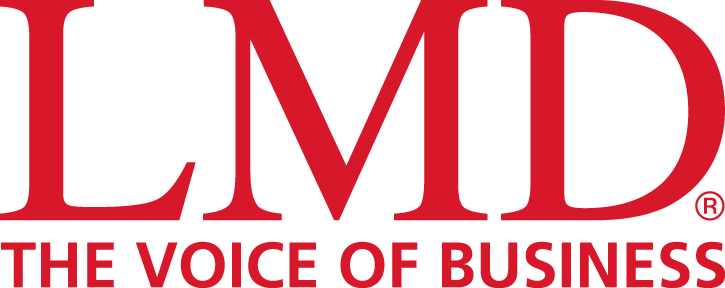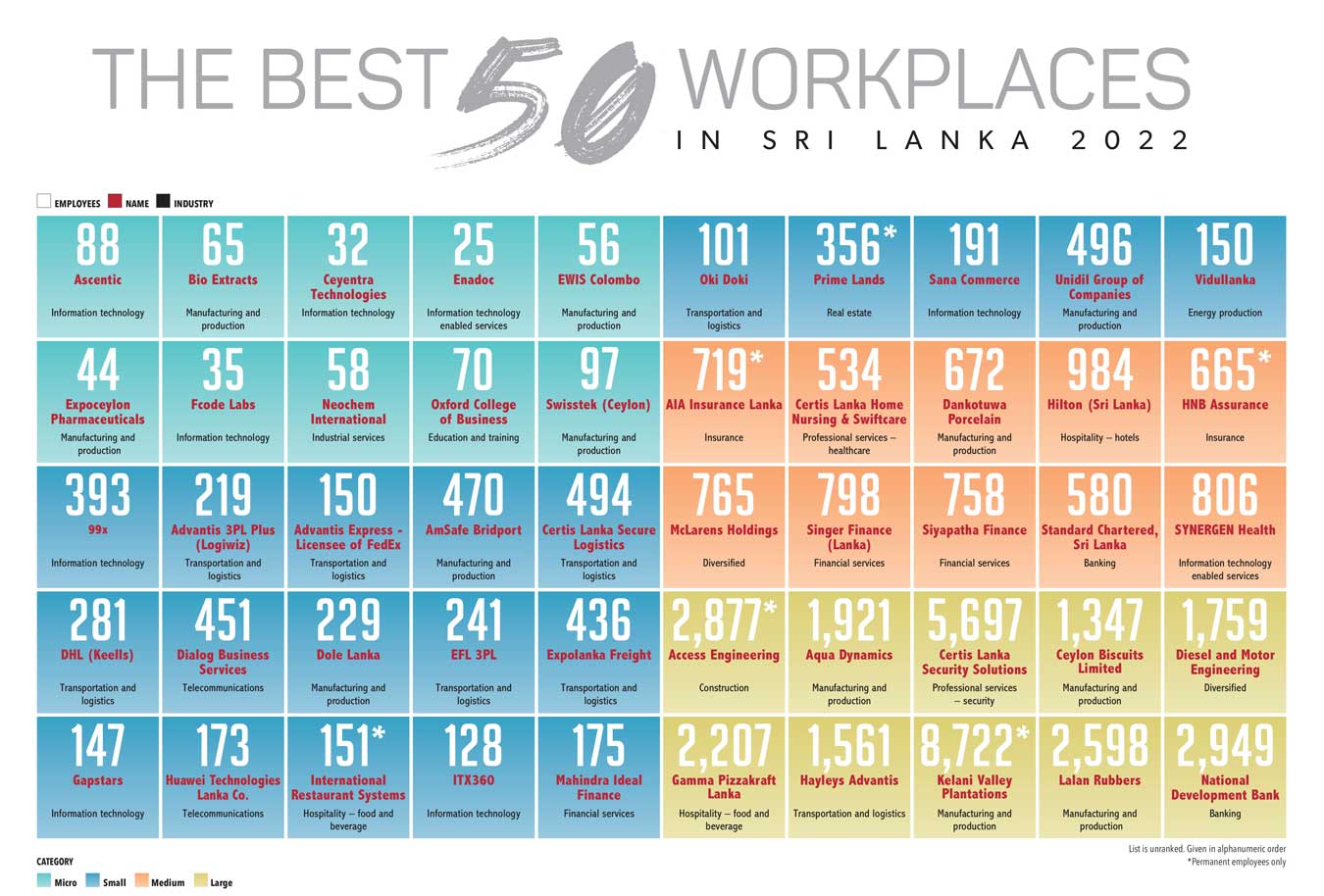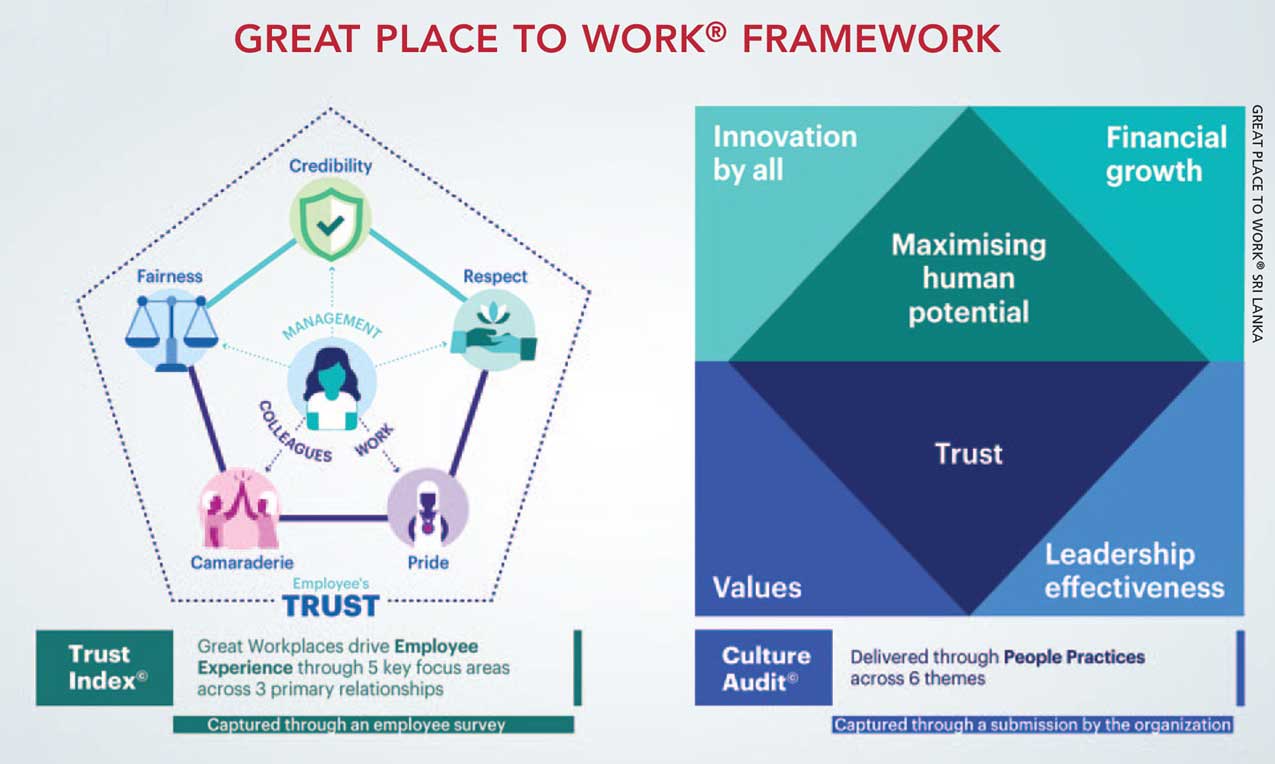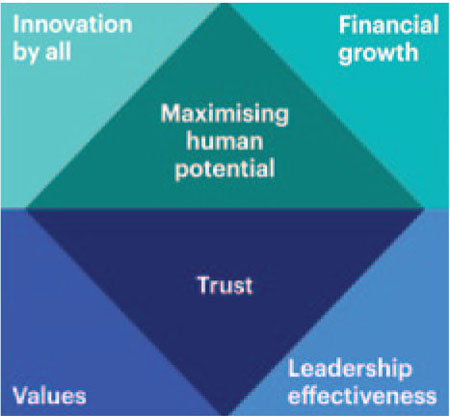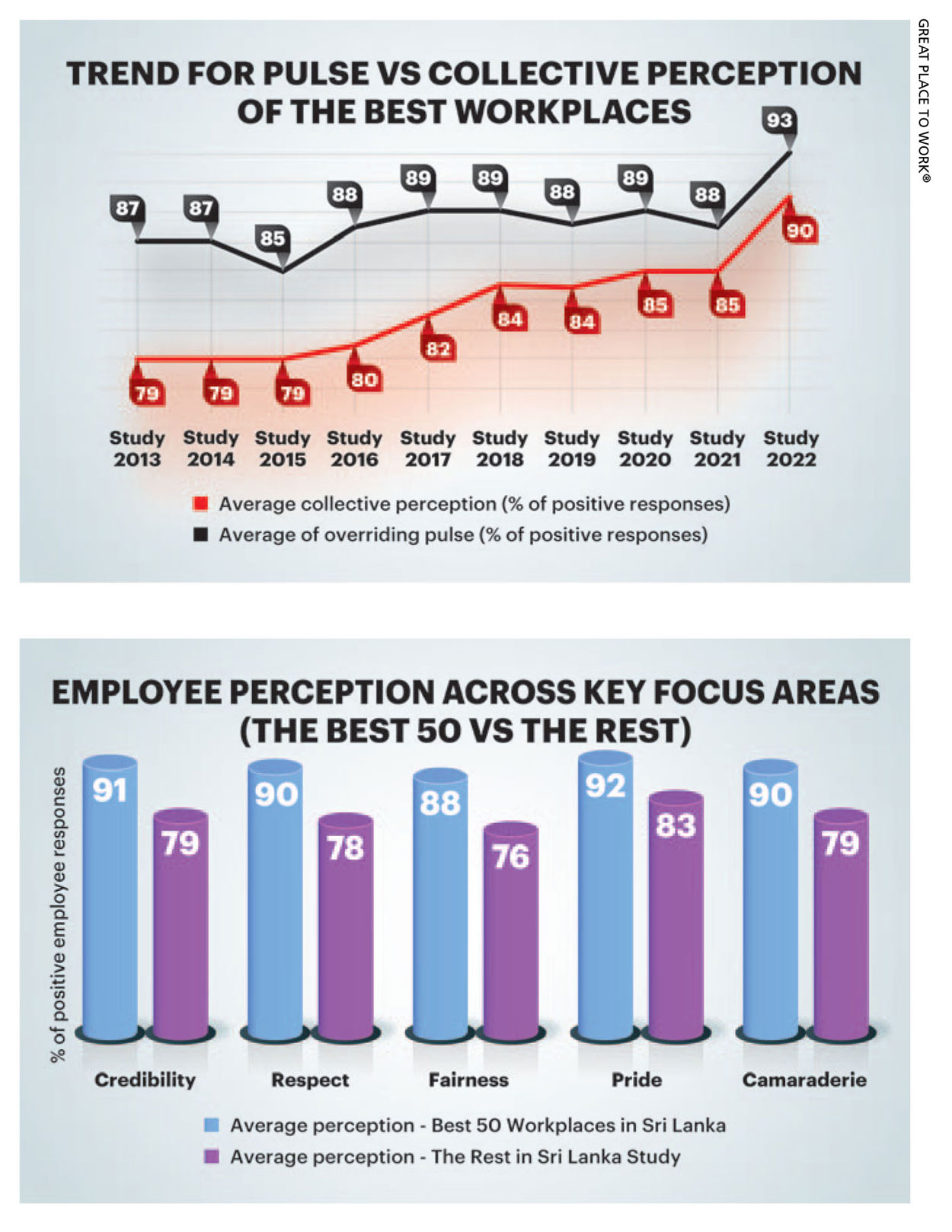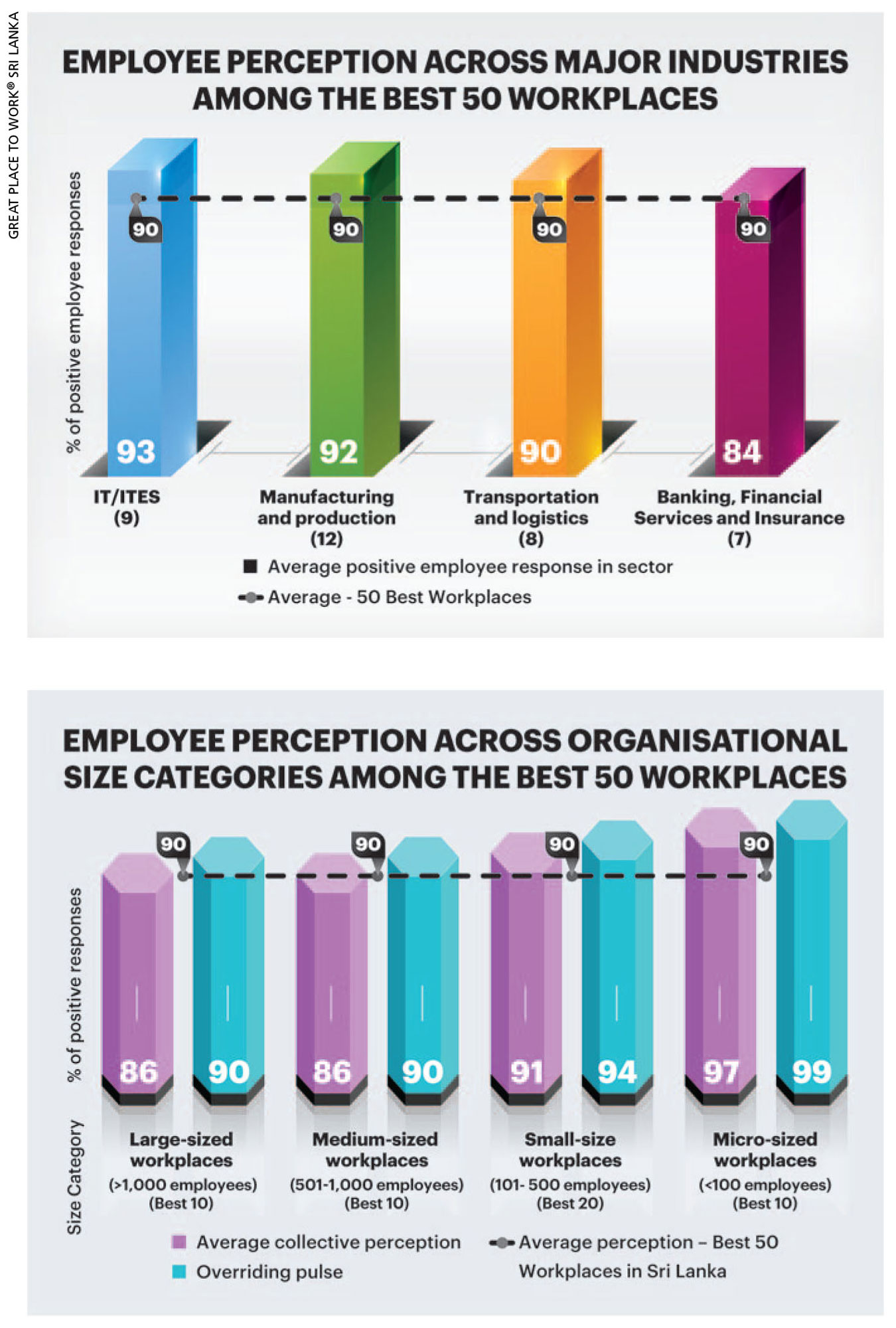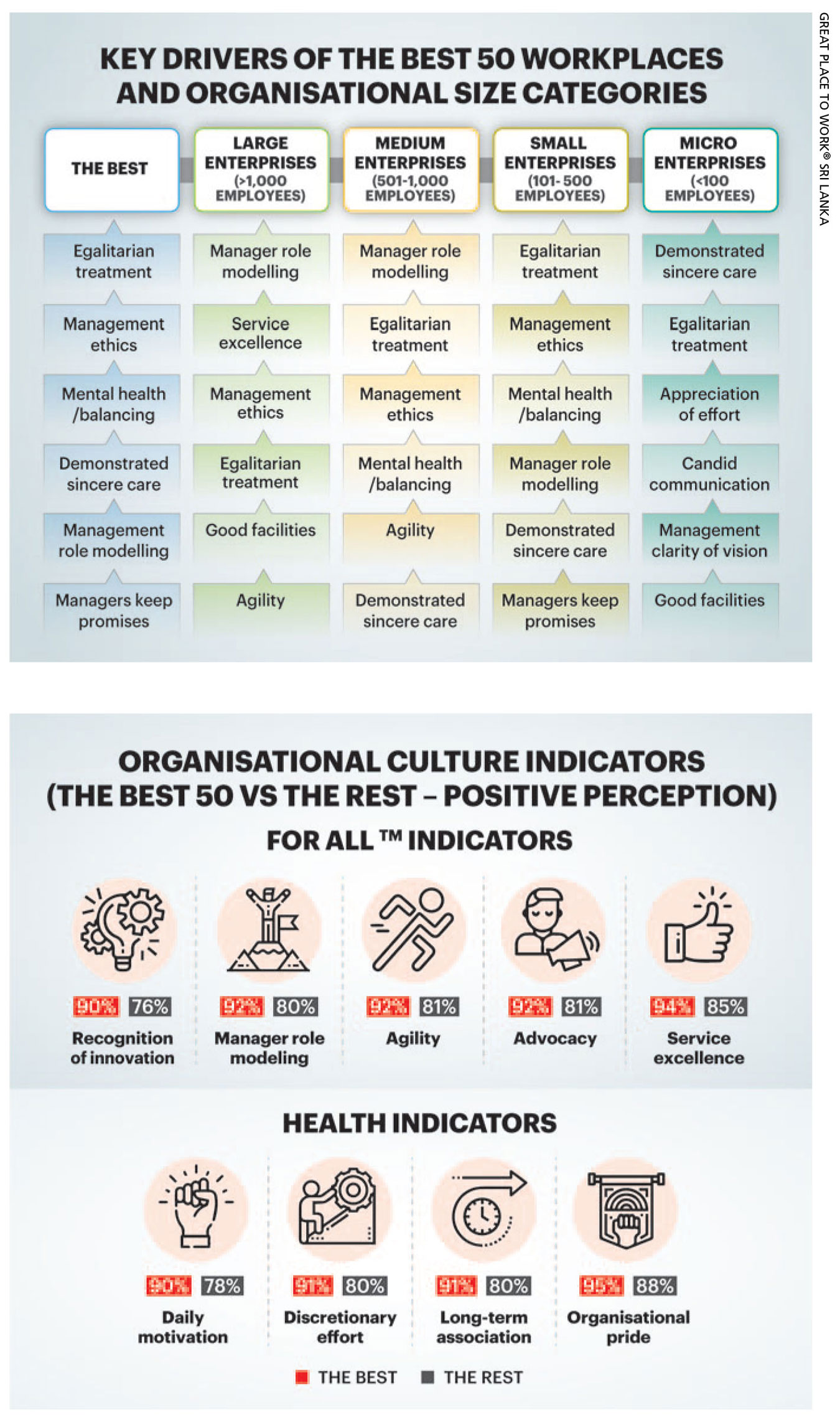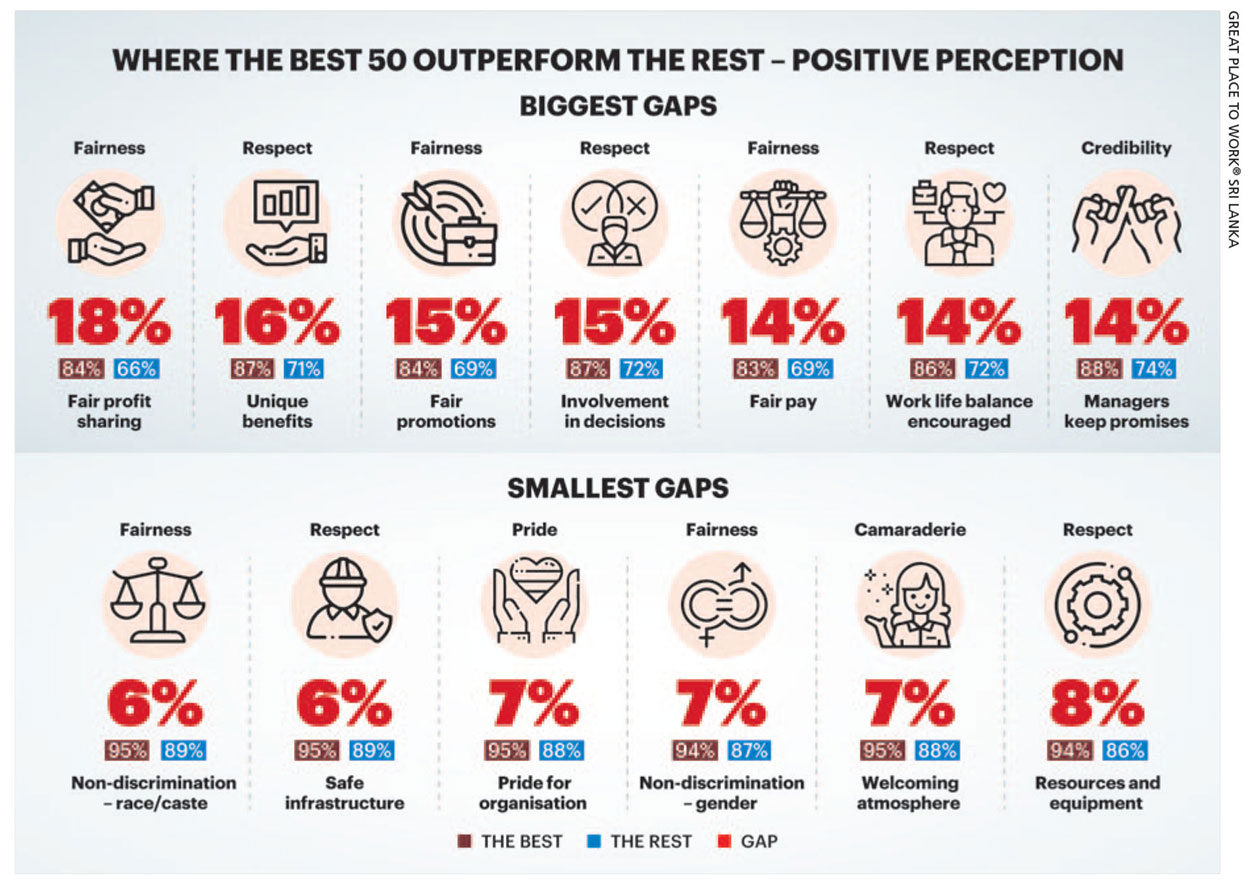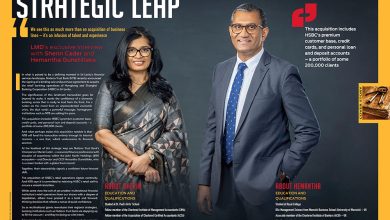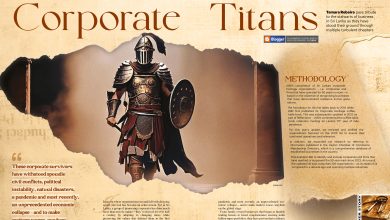
ASSESSMENT METHODOLOGY
Great Place to Work® Inc. has pioneered studying and recognising Best WorkplacesTM around the world for over 30 years, and assesses organisations in more than 70 countries across 100 territories.
The Sri Lanka study is based on the global model and a rigorous methodology, which have been researched, tested and utilised in similar studies around the world. This model applies across all geographies as it primarily measures the hygiene factors in the work environment that are considered requisites of a foundation for a Great Place to Work For All™.
Eighty-five percent of the Great Place to Work For All™ evaluation is based on the experience of trust and of employees reaching their full potential as part of the organisation regardless of rank and role. These experiences are analysed relative to each organisation’s size, workforce demographics and industry norms.
The remaining 15 percent of the evaluation is based on all employees’ daily experiences of innovation and the organisation’s values, and the effectiveness of their leaders in ensuring that these are consistently experienced.
GREAT PLACE TO WORK FOR ALLTM
METHODOLOGY
Great Workplaces For All is able to maximise human potential through effective leadership, meaningful values and a deep foundation of trust with all employees regardless of who they are or what they do.
When these qualities are in place, workplaces benefit from enhanced innovation and financial growth.
TRUST
Fundamental to a great workplace is a high sense of trust between employees and management. Leaders who are credible, show respect and are fair help drive experiences of pride and camaraderie.
MAXIMISING HUMAN POTENTIAL
A great workplace for everyone regardless of who you are or what you do in the organisation.
VALUES
An organisation’s values are not only those that are written down but also what employees actually experience in their day-to-day work lives and behaviours they see reflected by their leaders.
LEADERSHIP EFFECTIVENESS
An effective leadership team has an emotional connection with an organisation’s culture and its people, and the ability to create a coherent and effective strategy for every level of the business.
INNOVATION BY ALL
A great workplace culture enables an organisation to continuously improve, adapt quickly and generate pivotal opportunities, by tapping into the aptitude, skills and passion of everyone in the organisation.
FINANCIAL GROWTH
Financial growth is an expected outcome of a successful and positive great workplace culture. Great workplaces are those that have been built upon a vision and capability for long-term financial sustainability.
CERTIFICATION
The Great Place to Work-CertifiedTM programme recognises all eligible organisations that meet the gold standard for certification.
ELIGIBILITY
Organisations with 10 or more employees and a minimum of one year’s operations.
CRITERIA
An organisation in which at least 70 percent of employees confirm it to be a great workplace by rating it ‘positive’ on the Trust Index© survey by Great Place to Work® Inc. and on submission of a satisfactory Culture Brief©.
Organisations that are Great Place to Work-Certified™ with 20 or more employees can opt to forward their results for recognition in the Best Workplaces lists if they fulfil the eligibility criteria.
FOOTNOTE Great Place to Work® in Sri Lanka now publishes lists based on subcategories in certain demographics (e.g. Best Workplaces for Women, Best Workplaces for Millennials) and selected industries (e.g. Best Workplaces in IT/ IT enabled services (ITES), banking, financial services and insurance (BFSI), manufacturing and logistics).

THE FIRST STEP
The first step to being recognised as a great workplace is to voluntarily undertake a paid assessment with a view to being certified and opting to participate in the ‘Best Workplaces’ study.
While all organisations undertaking the Great Place to Work® assessment have the opportunity to be certified upon meeting global standards, participants who submit their results to the Best Workplaces study will additionally be considered for inclusion in the lists of the ‘Best Workplaces in Sri Lanka’ and the ‘Best Workplaces in Asia’ each year.
To qualify for the national Best Workplaces study, an organisation must have 20 or more employees and be a registered entity in Sri Lanka.

TWO LENS MODEL
The Great Place to Work ModelTM considers workplace culture from two perspectives: the employee perspective – whereby the employee’s perceptions of the workplace experience are averaged using the Trust Index© survey; and the manager perspective – whereby the quality of interactions intended through people practices established by the management is evaluated using the Culture Audit© tool.

EMPLOYEE EXPERIENCE
A unique employee centric framework is used to measure employee perceptions through the Trust Index© survey, a proprietary employee feedback tool developed by Great Place to Work®.
Comprising 59 statements and using a five point Likert scale, the universal instrument measures employee experience and counts for 75 percent of an organisation’s score.
Administered in multiple modes – i.e. email, paper or kiosk depending on the organisation’s requirements – the survey is available in all three local languages.
Through two open-ended questions, the tool captures employee comments about what makes their workplace great and what would make it better. And it encourages employees to submit their opinions and suggestions through anonymous responses.
As for improvement, quantitative survey results can be further verified through qualitative methods such as focus group discussions with selected employee groups to gather root causes for priority areas. Together with survey data, these can be used for action planning by the management team.

PARTICIPATION
To be considered, organisations must meet the Great Place to Work-CertifiedTM standard. To ensure that the outcomes truly represent all employees’ views, it is required that survey results be accurate to a 95 percent confidence level with a five percent margin of error or better.
For organisations that employ less than 1,000 people, all employees were selected to participate in the survey by default while larger organisations were assessed based on a random stratified sampling method.
Going forward, there will be a census survey for all organisations with less than 5,000 employees.

EVALUATION
A strict methodology for maintaining anonymity is followed so that individual responses cannot be tracked by organisations participating in the survey.
A stringent audit process is followed during and after completion of the survey. This provides employees with an opportunity to provide candid feedback on the organisation to maintain the assessment’s credibility.

MANAGER’S VIEWS
The managers’ perspectives and practices established by management are measured by a proprietary tool and evaluation framework called the Culture Audit©. This is a comprehensive questionnaire in which the organisation submits detailed information on the practices it has adopted, which is subject to rigorous evaluation.
This instrument helps gauge not only an organisation’s structure and demographics, but also its philosophy and values, and the manner in which they’re integrated into its people practices. The remaining 25 percent of the overall score is derived from this Culture Audit©.

SIZE CATEGORISATIONS
This year, organisations were ranked in the list of the 50 Best Workplaces in Sri Lanka based on size categories.
Workplaces with 20-100 employees were considered in the selection of the Best 10 in the ‘Micro’ category. Workplaces with 101-500 employees contributed to the selection of the Best 20 in the ‘Small’ category. Workplaces with 501-1000 employees contributed to the selection of the Best 10 in the ‘Medium’ category. And finally, workplaces with more than 1,000 employees were considered for the selection of the Best 10 in the ‘Large’ category.

POST-ASSESSMENT IMPROVEMENT
In order to improve organisational culture after an assessment, the two lens model can communicate employee feedback to help identify practices that may not be effective or require improvement.
These can be further studied by understanding root causes through focus group discussions with employees as well as an on-site culture audit – a methodology comprising a series of discussions with employees, people managers and practice owners/HR, to understand the implementation and effectiveness of practices submitted.
This data can be used for action planning to improve perceptions and people practices in the organisation, and to create a better employee experience.
Note that this ranking was finalised prior to the Sri Lanka Economic Crisis in 2022 and does not reflect organisations’ roles or responses to their people or community in addressing its impact.
THE BEST AND THE REST
Great Place to Work® showcases the Best WorkplacesTM in Sri Lanka based on its new classification
As the nation reels from one shock after another and the rate of inflation – as measured by the Colombo Consumer Price Index (CCPI) on an year on year basis – came in at 45.3 percent in May, working people will increasingly look to workplaces for stability and security.
This assessment whilst providing invaluable insights and guidance to corporate leadership, was undertaken and assessed at a time when the gravity of today’s challenges were barely contemplated.
Now more than ever, these findings are relevant for organisations aiming to maintain their reputation as great places in which to work.
By publishing the Best WorkplacesTM in Sri Lanka for the 10th consecutive year, Great Place to Work® continues to showcase organisations that engender an overwhelmingly positive work experience for their employees.
Great Place to Work® is the global authority on workplace culture. As the number of organisations utilising its model, tools and recognition programme have increased significantly, a list of the 50 Best Workplaces in Sri Lanka is published this year.
The 2022 study uses the enhanced Great Place to Work For AllTM model, which includes additions to the fundamental trust based model that act as supplementary pillars to differentiate the elite Best Workplaces from certified Great Workplaces.
In this study cycle from April 2021 to March this year, approximately 72,350 employees were surveyed with an average response rate of 85 percent. The sample represented over 160 organisations and a workforce of 94,000 across more than 20 sectors. The outlined methodology was maintained in the selection of the list of the best 50 workplaces.
THE BIG PICTURE Over the past decade, the overriding pulse in response to the single statement ‘taking everything into account, I would say this is a great place to work’ has seen a steady ascent with a reassuring leap of five points in the last year.
The recovery from the pandemic and the general swell of good feeling towards organisations that have supported their employees could be a factor for this sharp increase.
FOCUS AREAS A glance at the five key focus areas of credibility, respect, fairness, pride and camaraderie shows that pride is the best performing area on average, with fairness the lowest on the radar of employee perceptions in both the best and the rest workplaces.
DEMOGRAPHICS Analysing the various demographics, overall there is no notable difference based on gender. Women scored lower than men only on the statement ‘I feel I make a difference here’ – perhaps this area of ‘pride in personal job’ is one which should be considered when addressing gender parity.
A third gender option of ‘other’ was introduced during this study in line with encouraging diversity but no significant data was captured.
Millennials (i.e. 26 to 34-years-olds) continue to be the age group least positive in the best workplaces but only by a five point gap from the highest scoring group of 55 and older. Ironically, among the rest it is the 45 to 54-years-old age group that is least positive with a significant gap of 13 points to the most positive group of 55 and older.
In responses based on tenure, the newest employees (less than two years) are the most positive on average across all surveyed organisations. The best manage to maintain a consistent experience on average among the tenure groups whereas a clear trend line of decreasing positive perception with increasing tenure can be seen among the rest.
SECTOR PERCEPTIONS Approximately 20 key sectors are represented in the study – with the highest participation in the study from the sectors of manufacturing and production (25%), IT (17%), transportation and logistics (12%), banking, financial services and insurance (BFSI) (11%), and a variety of professional services (10%).
The Trust Index© tool indicates that the IT and manufacturing and production sectors scored better than the average of 90 percent in the comparative view of employee perceptions across major industries with BFSI coming in six points below the average.
Interestingly, the average positive perception of employees in an organisation increases as the size of the enterprise decreases, with micro enterprises showing a notably high perception of trust.
KEY DRIVERS Reviewing the correlation between organisation size and the respective key drivers of employee perception of their organisation as a great workplace, it is heartening to note that all four categories of organisations chose egalitarian treatment as one of their top six drivers.
Among the large, medium and small organisations, there is an emphasis on management as role models demonstrating ethical behaviour. Large and medium organisations picked agility as being key while mental health/balancing made it to the list for medium and small enterprises, but not for large and micro category organisations.
Demonstrated sincere care becomes increasingly important to employees as the organisation’s size decreases, and good facilities appear as key drivers in large and micro organisations but not in those in between.
These drivers will change from year to year and across organisations but similar requirements exist notwithstanding organisational size, with the smaller organisations arguably having needs that require more sustained and focussed efforts.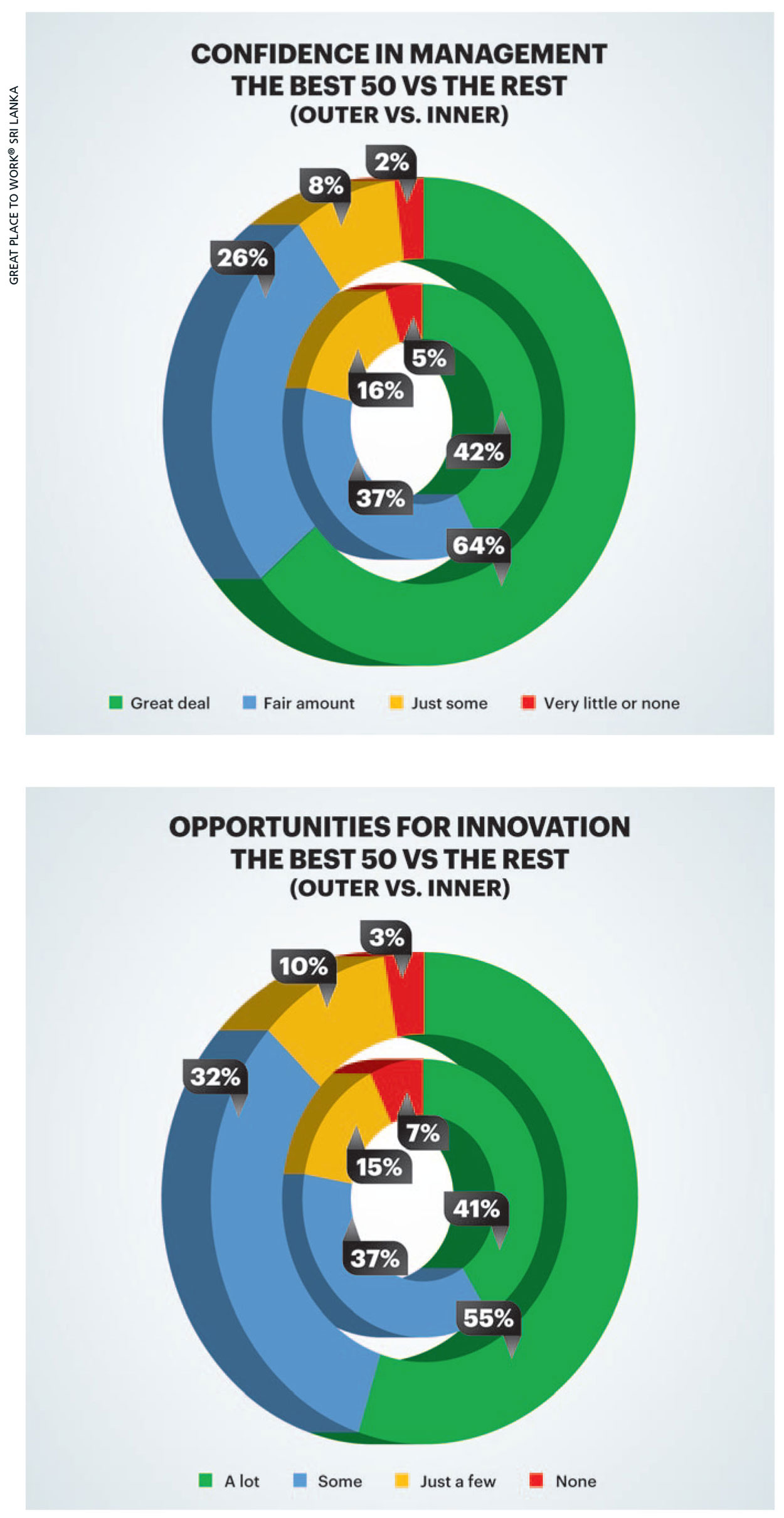
HEALTH INDICATORS The highest indicator for both the best workplaces and the rest is organisational pride. However, there is a significant disparity in positive perceptions with regard to recognition of innovation, manager role modelling, advocacy and agility, which are key indicators of the Great Place to Work For AllTM model and differentiators for best workplaces.
Since manager role modelling and agility appear among the key drivers as well, it is essential that any organisation aspiring to be among the best takes note and action.
HIGHLIGHTS Ninety percent of employees in the best workplaces have a high level of confidence in their management whereas this is only at 79 percent in the rest. Note that 21 percent of employees of the rest said they have little or almost no confidence in management as opposed to the 10 percent of those from the best.
Similar disparity is seen between the best and rest in assessing opportunities for innovation. For organisations aspiring to improve employee engagement and their bottom lines, this should prove to be food for thought.
THE BEST VS THE REST The best workplaces outperform the rest when it comes to profit sharing, unique benefits, promotions and involvement in decision making.
For organisations aspiring to the best workplaces list, here are some considerable insights. There is little disparity between the two in areas of discrimination and infrastructure so it would be fair to say that the workplaces surveyed are ‘safe spaces.’
By and large, the 2022 study highlights a positive movement towards higher employee perceptions of Sri Lankan organisations participating in it. In this competitive environment fraught with daily challenges, organisations must make every effort to continuously improve and empathise to keep pace with growing expectations.
The mission of Great Place to Work® is to help every enterprise become a Great Place to Work For AllTM so that human potential may be maximised through a High-Trust High-Performance CultureTM driving business and improving lives.
No matter where you are in your journey, you’re invited to join in and contribute to achieving the vision of making Sri Lanka a great place to work.
– Compiled by Great Place to Work® in Sri Lanka Best Workplaces List Manager Ruwani Alwishewa and Analyst Lahari De Alwis
FOOTNOTE For more information on how to begin your journey of becoming great, contact Best Workplaces List Manager ruwani.alwishewa@gptw.com – or call 0766 301200 or 4545594 (or visit www.greatplacetowork.lk).
CATEGORY AWARDS
The category awards distinguish organisations displaying excellence in areas related to the enhanced Great Place to Work For AllTM model, and engendering an overwhelmingly positive and consistent work experience for employees.
Recognition is within four clusters: Excellence in People Initiatives (two selected practices), the Cube Award for Special Recognition, Organisation Size and Classification, and Legends (organisations listed for five and 10 years in a row).
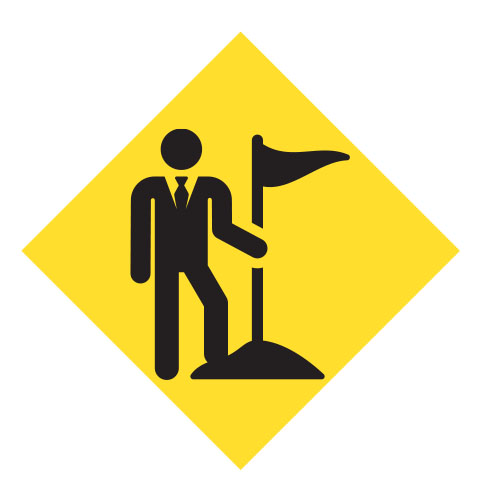
EXCELLENCE IN PEOPLE INITIATIVES Great Place to Work® in Sri Lanka considers this recognition as an opportunity to raise awareness and prompt best practices, and incentivise the creation and sustenance of great workplaces.
Organisations that are successful in these categories score high in both the submission – showcasing people practices (two-thirds of the final score) – and in their respective employee perception scores (one-third of the final score).
The enhanced model has categorised six key areas of focus for an organisation’s management. The two practices selected for this year’s awards are relevant to areas that can be better managed within the context of the Sri Lankan workplace culture to develop greater employee engagement.
And the awards are for excellence in ‘Living the Values’ and ‘Encouraging Opportunities for Innovation.’

EXCELLENCE IN LIVING THE VALUES A company’s values are not mere words displayed on its walls or on a website but rather, employees’ everyday experience at work and as visibly demonstrated by leadership.
Living the values creates a sense of pride among employees and fosters credibility in the management, whilst contributing to a more consistent and impactful experience across the workplace.
The award would go to an organisation founded on clearly espoused values that are relevant to the business and possibly unique to its culture. There would be a variety of practices and leadership behaviours in which the culture aligns to the stated values in daily practice.
Evidence of ways in which the values impact the culture must be actively demonstrated in the day-to-day experience of employees, and visibly guide the actions of leaders in strategy and critical decision making.

EXCELLENCE IN ENCOURAGING OPPORTUNITIES FOR INNOVATION Innovation is essential for the enduring success of a sustainable business and should ideally be a key aspect of business strategy.
A Great Place to Work For AllTM culture in which all employees can contribute towards long-term innovation is one that empowers a company to continuously improve, adapt quickly and generate pivotal opportunities, by tapping into the aptitude, skills and passion of everyone in the organisation.
This award is presented based on the extent to which all employees perceive they have been given opportunities to contribute towards continuous improvement.
First, an organisation must establish people practices that form an intentional approach towards encouraging all employees to periodically share new ideas and improved ways of doing things that contribute to creating and sustaining an innovation culture.
Second, great workplaces would also have in place distinctive policies and programmes that support the recognition, and reward of employees who participate and contribute to innovation.
And third, there should be a variety of examples and anecdotes of employees in different roles collaborating on suggestions, and of successful implementation, and the monitoring and evaluation of the impact of those ideas that were deemed of benefit to the organisation.
CUBE AWARD FOR SPECIAL RECOGNITION
BEST IN BOLD ACTS OF LEADERSHIP/MOVEMENT LEADERSHIP The best workplaces are those that have been established with a vision and capability for long-term sustainability and a significant positive impact on the community.
This year’s study collected information around bold acts of leadership in organisations to create a Great Place to Work For AllTM environment for employees and the community.
Movement leadership starts with leaders showing commitment to long-term business success alongside a steadfast dedication to making a positive change in the world. Bold acts or projects to be considered in this area would have a clearly defined scope, significant investment of resources, evidence of impact with measurable results, records of stakeholders influenced and why that showcases commitment to the cause being promoted.
CATEGORY AWARDS BY ORGANISATIONAL SIZE AND CLASSIFICATION
ORGANISATION SIZE (EMPLOYEE STRENGTH) The complexities and challenges of maintaining a great workplace culture for all employees vary with the size of the employee population.
Organisations ranked among the three best in class in their respective employee strength category (micro organisations of 20-100 employees, small organisations of 101-500 employees, medium organisations of 501-1,000 employees and large organisations of over 1,000 employees) are felicitated through this cluster of awards. The standard size category ranges have been revised and updated this year.
ORGANISATION CLASSIFICATION This includes the top multinational corporation (MNC) and public listed company (PLC) in Sri Lanka. The leading multinational corporation as well as public listed company in Sri Lanka are selected based on the highest combined score in terms of employee perception through the Trust Index© survey and people practices with the Culture Audit©.
LEGEND STATUS
Establishing and sustaining a great workplace is a journey. It takes sustained focus and dedication to a cause. Organisations that have proved their commitment to employee engagement and people management by gaining a place in the list for five and 10 consecutive years are recognised as ‘Five Year Legends’ and ‘Ten Year Legends’ respectively among the ‘Best Workplaces’ and inducted into the hall of fame.
Certis Lanka Security Solutions joined the list of Five Year Legends this year.
99x, AIA Insurance Lanka and Diesel & Motor Engineering (DIMO) are the first to be recognised as Ten Year Legends in Sri Lanka’s hall of fame.
BEST WORKPLACES IN ASIA
The Great Place to Work annual study of Asia’s Best Workplaces felicitate best workplaces in the Asia-Pacific region and Middle East. The regional list will distinguish organisations under three categories: Best Multinational Workplaces in Asia, Best Large Workplaces in Asia (> 500 employees), and Best Small and Medium Workplaces (< 500 employees) in Asia. The list considered results from the Sri Lankan study conducted from April 2021 to March 2022 and will be released on 31 August.
